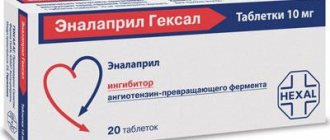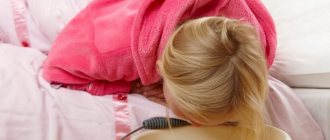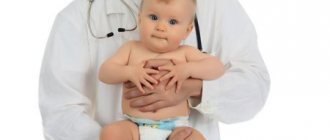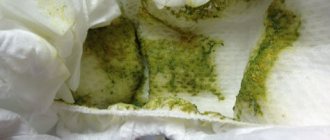Why does a child have foamy diarrhea and how to treat it?
Each internal pathological process is manifested by external clinical signs. They can be general or specific to a particular disease. A characteristic symptom of malfunctioning of the gastrointestinal tract in a child is considered to be diarrhea with foam. It is children who are most susceptible to the influence of harmful factors due to instability of the immune system and increased sensitivity of the body. Diarrhea with foam in a child should not be ignored. It is necessary to find out the exact reason for choosing the right tactics for treating digestive problems.
How is foamy stool formed?
Bubbles in loose, foamy stools are nothing more than gases. They are released during the life of microbes that have colonized the intestines. With normal digestion, a balance is maintained between the processes of putrefaction and fermentation in the large intestine. Putrefactive microbes - some types of bacilli, clostridia help digest protein, decomposing it into nitrogenous compounds. By-products of protein breakdown are gases - indole, skatole, hydrogen sulfide (rotten egg smell). It is these volatile compounds that give stool its characteristic “amber.”
Other microorganisms deal with complex carbohydrates - starch, inulin, fiber. Carbohydrates are fermented by lactic acid, butyric acid, and alcoholic fermentation. The main gaseous waste of the fermentation process is carbon dioxide. Typically, carbon dioxide is absorbed into the blood and excreted by the lungs. The carbon dioxide content increases sharply due to the dominance of yeast fungi in the intestines. They are responsible for alcoholic fermentation and feel very comfortable in the intestines, having plenty of simple sugars - glucose, fructose, sucrose, lactose.
If a person’s diet is based on complex carbohydrates contained in vegetables, fruits, herbs, and cereals, then lactic acid bacteria predominate, and digestion occurs as it should. When nutrition is incorrect, there is an imbalance of microflora. Colonies of microbes prevail, whose vital activity is accompanied by increased gas formation.
Why does this happen?
Foamy diarrhea in a child is observed at any age. It may be caused by the following factors:
- Bacterial infections such as salmonella, E. coli, dysentery, vibrio cholerae. They become infected through contaminated foods, drinks, and dirty household items. The incubation process in children is short, since the immune system is still weak. Poisoning with microbial toxins begins within a few hours. The temperature rises sharply. The child has a defensive reaction - nausea and vomiting. Liquid, foamy, light-colored stool is observed.
- Viral infections with intestinal tropism are manifested by vomiting and foamy diarrhea with blood. The temperature reaches 40 °C, the child complains of weakness and headache. Viruses spread through airborne droplets and contact.
- Foamy stools in newborns are caused by a lack of the enzyme lactase to break down milk sugar. A large amount of lactose accumulates in the intestines, which causes the growth of yeast flora and the release of carbon dioxide, which contributes to the appearance of foam bubbles.
- A similar clinic accompanies celiac disease - gluten intolerance. The plant protein gluten is included in some formulas. Breastfed babies discover this anomaly when introducing complementary foods made from oatmeal, semolina, pearl barley, and bakery products. The disease affects about 1% of people worldwide.
- Low enzymatic activity of the pancreas and liver due to age does not allow food to be completely digested. Undigested food serves as food for microbes and causes their overgrowth.
- After taking antimicrobial drugs, the death of beneficial flora is observed and its replacement by pathogenic flora that produces toxic substances and gases. They liquefy and foam stool.
- Poor nutrition, excess protein or fast carbohydrates in the diet. An abundant protein menu provokes the growth of putrefactive flora. The belching of rotten eggs begins, the feces smell of hydrogen sulfide. Those with a sweet tooth are at risk of increased gas formation, bloating, and foamy feces due to increased fermentation in the large intestine.
Children, fortunately, rarely have chronic diseases of the digestive system, although this is quite possible. Intestinal symptoms in the form of fever, diarrhea, and vomiting often accompany an acute infectious process. The role of parents is to prevent the transition of the acute form to the chronic stage of the disease.
Causes of loose stools with foam
There are many different reasons that can cause a child to develop loose, foamy stools. This list includes:
- abuse of carbohydrate foods, products that have a laxative effect and cause fermentation;
- lactase deficiency. Putrefactive bacteria living in the large intestine cause fermentation of milk sugar. As a result, the child develops loose, yellow, foamy stools;
- intestinal dysbiosis (a consequence of physiological immaturity, weak immunity or long-term use of antibiotics);
- allergic damage to the digestive tract;
- acute intestinal infections (escherichiosis, intestinal flu);
- intolerance to gluten (a protein found in many cereals).
Ways to eliminate foamy feces
Liquid, foamy feces against the background of the child’s deteriorating condition requires an immediate call to the ambulance and placement of the baby in a medical facility. Dehydration develops quickly in children; inept actions of parents can harm the health of the baby.
If the child feels relatively well, there is no vomiting or fever, but there is diarrhea with foam, gas, and abdominal discomfort, you can try home therapy. Features of the treatment of foamy loose stools are as follows:
- Replenishing fluid loss by drinking water, mineral water without gas, salt rehydrants such as Regidron, Oralit, Humana.
- Removing intoxication with sorbents. For these purposes, children use Smecta or rice broth. Passing through the intestines, these agents absorb excess water, toxic substances, and compact stool.
- Preparations that suppress foaming in the intestines in children, based on simethicone: Sab Simplex, Espumisan L, Bobotik. Herbal medicines for gases in infants - Plantex, extracts of fennel, anise, caraway, dill, mint.
- Astringent herbal remedies for diarrhea - decoctions of chamomile, sage, St. John's wort, oak bark, pomegranate peels.
- Colonization of the intestines with beneficial symbionts using the drugs Linex, Hilak Forte, Acipol, Bifidumbacterin and other probiotics. Cultures of lactic acid bacteria are contained in kefir, fermented baked milk, yogurt, cottage cheese, and yogurt.
- Changing your diet is important to combat dysbiosis. Fresh vegetables, fruits, and cereals rich in fiber will serve as a breeding ground for the necessary microbes. Preferred sources of animal proteins are chicken, turkey, rabbit, pike perch, and greenling fillets. Sweet, spicy, fatty, fried, pickled foods should be excluded.
Treatment of foamy diarrhea in children at home lasts no more than 3 days. If after this period there is no improvement, you should seek medical help.
Foaming diarrhea in children is caused by the overgrowth of certain colonies of microbes in the intestines. This can be caused by nutritional errors, metabolic disorders, enzyme deficiency, bacterial or viral infection, and antibiotic treatment. An examination by a doctor will determine the correct cause of the disease.
Treatment is aimed at replenishing moisture, removing toxins, eliminating foam, and colonizing the intestines with bifidobacteria and lactobacilli. A balanced diet, walks in the fresh air, and adequate sleep will increase the body’s defenses and speed up the child’s recovery.
The information on our website is provided by qualified doctors and is for informational purposes only. Don't self-medicate! Be sure to consult a specialist!
Treatment with folk remedies and prevention
Traditional medicine recipes are very popular among mothers. They act more gently on the body and have fewer side effects. But taking herbs and decoctions should be taken seriously. They can cause a severe allergic reaction, especially in infants. You should consult your doctor before taking herbs and honey.
Popular and safe folk remedies for treating diarrhea in children are:
- Chamomile and mint. Decoctions of these herbs can be added to tea and given little by little to the child. They relieve inflammation well, soothe the mucous membranes of the stomach and intestines, and stop diarrhea. The decoction in its pure form is drunk in small sips throughout the day.
- Honey. This useful product helps with many diseases. It has anti-inflammatory properties and restores intestinal microflora. However, honey is a strong allergen and should be given to children under 3 years of age with caution.
- Rice. A safe and effective remedy for diarrhea is the decoction that remains after cooking rice. Rice should be rinsed well with clean water after cooking. The drink is given to the child in small portions throughout the day.
- Tea. With diarrhea, a large amount of fluid is lost, so you need to drink a lot. In addition to clean water, black tea is useful, as it strengthens and stops diarrhea.
- Bird cherry. In bird cherry, both fruits and bark have a fixing effect. They need to be poured with boiling water and left to steep. The cooled broth is taken half a glass 2 times a day.
- Apples. Fresh fruits can increase gas formation and irritate the stomach and intestines. Therefore, it is recommended to give baked fruits to children. For babies, you can grind them in a blender. You should not add nuts or cottage cheese.
Blood in stool is a cause for concern
A child has bloody diarrhea - should parents worry? Yes, this is a serious cause for concern. First of all, you need to pay attention to the nature of the inclusions:
- scarlet droplets;
- marks on the diaper;
- red veins;
- clots mixed with mucus;
- dark red color of feces.
The nature of the inclusions can say a lot about the baby’s health and the pathology that caused the bleeding. The most harmless, if we can say so about bloody marks, are stains on toilet paper or a diaper. Most often, they indicate microcracks around the anus due to difficulty defecating and constipation. Other inclusions require immediate medical attention.
Find out from our video about the main causes of diarrhea!
Foamy stool in a child in the first days and months of life frightens young parents, but given the physiological characteristics of the infant’s body, there is no need to panic. To eliminate the danger, you should immediately visit a pediatrician and deal with the problem if it exists. Additional consultation, determination of what is considered normal and pathology should lead to a stable psycho-emotional state for the mother. Children are sensitive to the experiences of loved ones and a woman’s peace is above all else.
Why does a child have diarrhea?
What could be the cause of bloody diarrhea? Watery feces containing bloody spots indicate the presence of a pathological process in the digestive tract. Bloody diarrhea is a symptom of the following ailments:
- congenital gastrointestinal disorders;
- dysbacteriosis;
- tumor processes;
- infectious infections;
- helminthic infestation;
- inflammation of the mucous membrane of one of the sections of the gastrointestinal tract;
- stomach and duodenal ulcers;
- mechanical damage.
With the introduction of complementary foods, stool becomes harder, but diarrhea may appear as a reaction to a certain product. In this case, there should be no blood in the feces, and if it appears, parents need to take the baby to the pediatrician.
Where does blood come from in stool?
Why does blood appear in the stool during various illnesses? The walls of the organs of the digestive system are covered with small vessels. Vessels are injured when:
The table contains information about the most common infectious diseases:
| No. | Name | Pathogen | Characteristic | Symptoms |
| Salmonellosis | Salmonella | Bacteria settle on the walls of the small intestine and, as a result of their vital activity, release a toxin that disrupts vascular tone and depresses the central nervous system. | High temperature up to +39°C, nausea and vomiting, liquid, watery green diarrhea streaked with blood, dehydration. | |
| 2 | Rotavirus infection | Rotavirus | The virus infects the epithelium of the mucous membrane of the villi of the small intestine and causes their death. | The symptoms resemble the flu, which is why the disease is mistakenly called “stomach flu.” Vomiting and diarrhea are accompanied by sore throat, runny nose, and cough. |
| 3 | Shigellosis | Shigella bacteria | In the small intestine, toxins are produced that cause general intoxication; in the large intestine, they destroy the epithelium, forming ulcers. | Diffuse, dull pain in the abdomen, pain during bowel movements, decreased blood pressure, high temperature. |
| 4 | Enterocolitis | Bacteria of the genus Clostridium | Due to improper treatment with antibiotics, Clostridia microbes actively multiply in the intestines. | Watery stools with mucus and blood, bloating, abdominal pain, general intoxication. In case of complications, intestinal perforation is possible. |
Damage to the intestinal walls
Little children are eager to taste everything. As soon as the mother turns away, the baby is already putting the toy in his mouth. That is why it is not recommended to buy games with small parts for 1-2 year old children: construction sets, puzzles.
If your baby has swallowed a sharp object - a metal part, a needle, a pin, a fish bone - you should immediately consult a doctor. If an ordinary button comes out naturally, the nail can severely damage the walls of the gastrointestinal tract. Such mechanical damage is fraught with internal bleeding.
Infections with certain parasites also contribute to damage to the intestinal walls. Giardia sticks to the mucous membrane, thus injuring its surface. In addition to general intoxication from excreted waste products, Giardia causes inflammation and intestinal erosion.
Damage to the anus, hemorrhoids
With prolonged constipation, damage to the anus, micro-tears and sphincter cracks are possible. If a child does not eat properly and drinks little fluid, then his stool contains little water. Due to impaired peristalsis, they stagnate, turning into a hard and dry lump. When released, feces stretch the anal sphincter and injure it.
Hemorrhoids are pathological enlargement and inflammation of the hemorrhoidal veins that form nodes around the rectum. During defecation, the nodes are injured, and a small amount of blood is released with feces. Most often these are scarlet drops, but dark clots can also come out. Unlike infections, exacerbation of hemorrhoids occurs without an increase in temperature.
CHAIR AT THE BABY
The number of dirty and wet diapers a breastfed baby has is a very important indicator of his health. Variations in the normal consistency and frequency of an infant's stool are quite wide.
In the first 2-3 days of life, it is normal for babies to wet only 1-2 diapers per day. As mom's milk supply increases, so does the amount of wet diapers. In the first days after birth, newborns' stool is dark and thick, called "meconium." Meconium accumulates in the baby's body even before birth. As the baby begins to receive milk, meconium is cleared from the intestinal tract, and after a few days the stool becomes softer and significantly
lighter. Typically, a baby's stool is yellow, green-yellow, or yellow-brown. It is also considered normal if the stool sometimes turns green. The smell should not be strong or particularly repulsive. The consistency can be described as runny cottage cheese, custard, pea soup or mustard. Often small particles that look like seeds can be seen in the stool.
After the first few days and until about 6 weeks, most babies have two to five bowel movements per day. The volume of feces should be approximately the size of a walnut. Some children may have bowel movements more often, while others may have fewer bowel movements. If a baby under 6 weeks of age has bowel movements less than twice a day, this may be part of the norm, provided that the baby is peeing sufficiently and gaining weight normally, and of course, if the total volume of stool is significant. After the milk comes in, a fully breastfed baby should wet 6-8 cloth or 5-6 disposable diapers per day. To check urine volume, pour 2-4 tablespoons (30-60 ml) of water onto a dry diaper. A baby's wet diaper should feel approximately the same. Of course it's easier to see that
Source
Diagnosis and treatment of bloody diarrhea is a matter for the doctor
The first step is to contact your pediatrician. He will ask questions about how often blood appears in the stool, what symptoms accompany this, and will perform an initial examination. After this, the doctor will write out an appointment for the following tests and procedures:
Treatment is prescribed depending on the examination results:
- In case of infectious infection, the doctor prescribes antibiotics; to eliminate dehydration, drugs are prescribed that restore the water-salt balance. After antibiotic therapy, the intestinal microflora should be restored to prevent the occurrence of dysbiosis.
- In case of enterocolitis or inflammatory processes, the child is admitted to the hospital. Treatment in a hospital or even surgery is necessary when the cause of blood in the stool is mechanical damage to the digestive tract.
- During severe diarrhea, the pediatrician prescribes rehydration and absorbent agents. Kids can drink Smecta, Regidron, Enterosgel, activated carbon.
In addition to drug treatment for bloody diarrhea, children are prescribed a special diet. Difficult to digest dishes are removed from the menu: fried, fatty, salty, baked goods. It is recommended to fill the diet with strengthening foods: rice, potatoes, bananas, crackers. During lactation, a nursing mother goes on a diet.
Foamy stool in a newborn
One of the main indicators of a child’s health is his stool. After the baby is born, the mother constantly observes and notes the color, consistency and frequency of bowel movements.
Normally, a baby's stool should range from light yellow to brown, but it can be a different color. The normal consistency is considered to be mushy stool. But mucus, particles of undigested food, blood, and too watery or foamy stools should attract your attention. You should also always take into account the baby’s well-being and the presence or absence of additional symptoms. After all, “suspicious” bowel movements can almost always turn out to be normal (in isolated manifestations).
Parents need to know that foamy stools in themselves are rarely a warning sign. This can sometimes happen, because the baby’s intestines develop, train, and test their capabilities.
So, if in some cases you notice foamy stools in a newborn baby without other exciting manifestations, do not focus on this. But if the foamy stool has an unpleasant odor and a dark green color, or if it is observed constantly, then it is better to consult a pediatrician to determine the cause of this condition.
Causes of foamy stool in a newborn
Mom should know that breast milk is divided into fore and hind milk. The first serves as a drink for the baby (it contains vitamins, minerals, and other beneficial substances, among which the main one is the carbohydrate - lactose), the second - saturates. Lactose is very difficult to digest and only under the action of the enzyme lactase. This enzyme is produced by the child's body, but it is not enough to break down all the lactose that passes through breast milk. For this purpose, there is hind milk, which contains the missing amount of enzyme.
The health of newborns is determined by many indicators, but the most noticeable one is stool. All mothers pay attention to the color, consistency and quantity of stool and, when comparing, are guided by the “reference” standards described in various baby care manuals. The slightest deviations from the described norms cause anxiety in many mothers, and such phenomena include foamy stool in an infant.
Causes
Most often, diarrhea with blood is caused by internal diseases. Less commonly, malnutrition and external factors. As soon as parents notice bloody streaks and mucus in loose stools, they need to think about what could have caused such a nuisance.
Nutrition
- Food poisoning.
- The child has eaten too much vegetables or fruits that have a laxative effect.
- Poor quality products.
Diseases
- Keep in mind that diarrhea with mucus in a child under one year old is normal, since the formation of his gastrointestinal tract is not yet complete.
- Pathogenic microorganisms in the intestines.
- Infectious diseases: salmonellosis, gastroenteritis, dysentery, rotavirus infection, colitis.
- Inflammation of the mucous membranes in the intestines, esophagus or stomach.
- Internal hemorrhoids.
- Allergic reaction.
- Dysbacteriosis.
- Ulcer.
- Enzyme or lactose deficiency.
- Cancer diseases.
- Crohn's disease.
- Teething.
- Helminths.
External factors
- Stressful situations.
- Getting into the stomach of small parts that injure the mucous membrane.
- Taking medications.
- Failed operation.
All these factors must be taken into account if a child has diarrhea with blood and mucus. They will help make an accurate diagnosis, on which treatment will depend. Before visiting a doctor, parents can conduct a preliminary examination themselves and draw a conclusion about what is happening to their baby.
Debunking the myth. It is not true that a child’s diarrhea will go away on its own; it requires qualified diagnosis and medical treatment.
Variants of normal stool in a baby
Traditionally, mushy, sour-smelling, yellow-colored stools (possibly containing lumps) are considered evidence of normal intestinal functioning in a baby, but this norm is only relevant for artificial babies. The constant composition of the formula used for feeding ensures stable stool characteristics, and the composition of breast milk undergoes changes associated with the mother’s nutrition and the duration of lactation.
Uninformed mothers are scared by the color of the baby's first stool (meconium), but putty-like black-green stool is the norm for a newborn. This dark shade persists for the first few days of life. With properly organized feeding, after a few days the stool becomes green in color and has a thinner consistency. After colostrum is replaced by milk, the feces acquire different shades - yellow with artificial feeding and yellow-brown with breastfeeding.
Since the baby’s enzyme system has not yet fully formed, the baby’s feces may be:
- with a small amount of mucus
- with yellow and white lumps
- liquid or puree
- with sour milk odor
A one-month-old baby has bowel movements at least 3 times a day, and the maximum is after each feeding . After 1.5 months, stool can be observed after each feeding, and once a day. The absence of regular bowel movements in newborns is not considered constipation if the stool does not change its consistency and the child does not experience discomfort. In this case, rare bowel movements are associated with good absorption of mother's milk.
Close attention should be paid to the child if:
- stool contains large amounts of mucus
- there are pieces of undigested food or blood in the stool
- the stool is very light, black or green in color
- your baby has watery or foamy stools
The presence of mucus (especially white), blood, white and black stool requires consultation with a doctor if the baby’s health worsens or changes in the baby’s behavior.
Foamy stools are scary because they are unusual, but they are rarely a sign of serious illness.
Associated symptoms
As soon as you see your child has diarrhea streaked with blood or mucus, take a closer look at the stool. Their color, smell and contents can tell a lot. Associated symptoms will help you take the necessary measures even before the doctor arrives.
Diarrhea with light and bright scarlet bloody impurities indicates intestinal colitis in a child or dysentery.
If the bloody spots are dark, an ulcer should be suspected, which is very rare in children.
If you have diarrhea with blood and mucus without fever, this can be a little reassuring, since the situation is not so dangerous. This is not an infection or inflammation.
Diarrhea with fever, blood and mucus is a symptom of an intestinal infection. It can be recognized by such signs as weakness, headaches, cramps and pain in the abdomen, vomiting, green stool with a pungent odor.
Often, a child’s diarrhea with mucus is diagnosed as a harbinger of a rotavirus infection, which in a couple of days will manifest itself as a runny nose, migraine, lethargy and headache.
If the mucus in your diarrhea looks like orange or green flakes, it could be salmonellosis or coli infection.
- Itching of the anus
If, after diarrhea with blood and mucus, the child complains of itching of the anus, this may indicate the presence of internal hemorrhoids.
If it seems to you that your child has diarrhea mixed with blood, you should take a closer look at his bowel movements. Very often, overly suspicious mothers mistake ordinary veins of incompletely digested red foods eaten by the baby recently for blood. It could be tomatoes or beets. So panic may be completely unfounded. But if it is still blood with mucus, call a doctor, and before he arrives, try to alleviate the baby’s condition on your own.
With the world on a thread. Medicine knows such a dangerous disease as Brainerd's diarrhea. Its peculiarity is that it lasts for several months and, in the absence of necessary measures, leads to death.
When should you worry?
Liquid stools with foam in a child can occur for various reasons. This is not always due to serious diseases and pathologies. You should not ignore digestive disorders, but starting treatment from the first symptoms is also undesirable. The pediatrician will determine what led to the foamy diarrhea and prescribe adequate treatment. In case of increased gas formation and infantile dysbiosis, taking medications is not required. The condition normalizes over time.
You should worry when warning signs of disease appear. These include:
- Increased body temperature. Hyperthermia indicates the presence of a focus of inflammation in the body. The temperature rises with colitis, pancreatitis, intestinal infections, for example, staphylococcal. In this case, you must immediately show the child to the doctor.
- Stomach ache. Such unpleasant sensations arise due to increased intestinal motility. Foamy stools and abdominal pain are characteristic of an acute attack of pancreatitis.
- Change in stool color. Green stool indicates infection or dysbacteriosis, light stool indicates liver disease, black stool indicates the presence of internal bleeding. The first thing you should pay attention to is the color of stool.
- Vomit. Vomiting is also characteristic of pancreatitis. And also nausea and vomiting occur with food poisoning, sometimes with an intestinal infection. The combination of diarrhea and vomiting increases signs of dehydration and increases the amount of fluid lost. In this case, it is better not to hesitate and consult a doctor as soon as possible.
- Skin rashes. Foamy diarrhea and rash indicate an allergic reaction to a certain product or the presence of helminthic infestation. Intestinal parasites disrupt intestinal function and often provoke allergies.
It is worth paying special attention to the duration of diarrhea. If it does not stop for several days, you need to seek help.
You should not give your child medications for diarrhea until the cause is determined. The drugs strengthen, but do not eliminate the root cause, for example, infection.
If you have problems with the intestines and the first signs of dehydration (lack of tears when crying, dry throat, pale skin, small amount of urine produced), you should call a doctor. The main danger of diarrhea is that a large amount of fluid is lost.
First aid
Parents should know what to do if a child has diarrhea with blood and mucus, what medications can alleviate his condition and help avoid complications.
- Call a doctor.
- Do not throw away or wash off diarrhea mixed with blood and mucus to show it to a specialist.
- Do not feed the child.
- Give drinks in small portions (10-15 ml) every 5 minutes.
- Water can be replaced with special solutions of Regidron or Orolite.
- If the temperature rises above 38°C, give a paracetamol-containing drug in suppositories or syrup. Aspirin is allowed only from 12 years of age.
- Wash your child after each attack of diarrhea.
- Smecta, activated carbon, Polyphepan, Polysorb, Enterosgel are allowed - they help remove toxins from the body and eliminate infection.
Baby's chair
Most modern parents are concerned about the baby's stool. No matter how often it appears, what consistency or color it is - these are very pressing questions. It is difficult to know what is normal and what is outside the norm. Quite often, panicking parents cause pediatricians a lot of anxiety. Even one day of delayed bowel movements seems unbearable for many. But, after all, the baby adapts to the outside world and knows how to react to it. And caring and overly zealous parents can only watch their child and help him if necessary.
What kind of stool does the baby have?
So, first of all, you need to figure out what kind of stool a baby should have. Exact numbers and standards are not given in this case. Everything is purely individual and the baby’s stool is formed based on the portion eaten and the quality of the food consumed. It is quite normal if the baby's stomach is cleansed after each breastfeeding. This happens regularly in the first weeks. If there is no emptying, then there is no need to panic. It may appear in 2-3 days. And this is also natural.
Diagnostics
If there is diarrhea with blood and mucus, the child may be prescribed the following tests to clarify the diagnosis, since it can be a symptom of a variety of diseases:
- coprogram;
- stool tests for dysbacteriosis and helminths;
- general and biochemical blood tests;
- Ultrasound of the abdominal cavity.
These are the main diagnostic methods for diarrhea with blood and mucus in children, but in some cases additional studies may be prescribed depending on the situation. Once the diagnosis is confirmed, a course of treatment will be prescribed.
According to statistics. The peak of visits to the hospital with childhood diarrhea occurs in the spring-summer season.
Treatment
Treatment for diarrhea with blood and mucus is selected by a doctor (gastroenterologist or pediatrician) depending on the causes of this condition. Typically, the child is protected from contact with other people during therapy to avoid the spread of infection.
Drug treatment
- If bloody diarrhea in a child under one year of age is caused by an inflammatory process in the intestines, enterocolitis, or intussusception, he will have to undergo hospital treatment under the supervision of a doctor.
- For bacterial infections, antibiotics are prescribed.
- Prescribe medications that restore water-salt balance.
- For colitis, medications that relieve inflammation are prescribed.
- To eliminate diarrhea, adsorbent agents are given: Polysorb, Smecta, Enterosgel, activated carbon, Polyphepan, Neosmectin.
- Rehydration therapy is carried out to replenish fluid: drinking Regidron, compotes, saline solutions, mineral water, glucose.
- To normalize the intestinal microflora, lacto- and bifidobacteria are recommended.
Diet
- Foods that are difficult to digest are excluded from the diet: fruit juices, dairy products, raw vegetables and fruits, salty, sweet, fatty, fried foods, peas, beans.
- The menu actively includes bananas, crackers, rice water, potatoes, boiled water, weak tea, and jelly.
- If there is diarrhea with blood in an infant, the nursing mother goes on a strict diet, but lactation is not canceled.
- If the baby is artificial, it is recommended to switch to feeding a soy-based formula.
Folk remedies
- Infusion or tea of mint, chamomile;
- rice or pomegranate broth;
- blueberry;
- starch diluted to a semi-liquid state in plain water;
- carrot puree diluted with water.
In case of diarrhea with blood and mucus, the use of folk remedies for the treatment of children should be carried out only after consultation with a doctor. In some cases, they can cause irreparable harm to health and cause irreversible consequences.
On a note. Very often, children with diarrhea are prescribed Imodium, the average price of which is about 300 rubles. However, Loperamide, which costs only 25-30 rubles, has a similar effect.
Parental behavior
Methods of assistance will depend on each specific situation. Incorrect nutrition of a nursing mother or other errors in feeding the baby can be corrected independently without the use of medications. When there has been medication treatment that has caused an intestinal disorder, it is necessary to consult a doctor before starting therapy.
Dr. Komarovsky recommends that all mothers who suspect lactose deficiency in their child organize the lactation process according to all the rules (more details in the article: what are the signs of lactose deficiency in infants?). Be sure to ensure that the baby completely grasps the nipple with his mouth, and also that air does not enter the stomach when sucking. Allow your one-month-old baby to “hang” on your breast longer to be able to “get” to your hindmilk. Inadequate emptying of the breast requires sucking up the remainder during the next feeding. Offer your breast to your baby at least once every 2-2.5 hours. More frequent latching is good for your baby, so try to maintain an on-demand feeding schedule.
Feeling that the baby is not getting enough to eat, you should pay more attention to the process of breastfeeding itself. Studies have shown that there are no genetic predispositions regarding lactation, and absolutely every woman is able to breastfeed a child if the correct regimen is taken into account. Otherwise, the mother will have to use formula as a supplement.
Doctors believe that if the regime is followed, any mother can establish lactation
Act based on the situation and keep a close eye on your baby’s well-being:
- Prevention measures. Everything is simple and banal: regular hygiene for adults, hygienic care for the baby, nutrition for a nursing woman, introduction of complementary foods in a timely manner, with approved products, breastfeeding technique.
- Do not self-medicate. Do not listen to the advice of mothers sharing their experiences on unprofessional forums and do not get carried away with traditional medicine. A harmless foamy stool in a newborn, after a discussion on the Internet, can develop into a monstrous disease in the eyes of the mother.
- Visit a doctor. Start therapy only after consulting with a pediatrician and prescribing tests and medications.
- Taking tests. It will be mandatory to take a general clinical blood test, as well as an analysis for dysbacteriosis and lactase deficiency.
A more detailed examination can be done by a gastroenterologist. He will help identify the causes of foamy stools and prescribe the required treatment. Perhaps this will not be required, then the doctor will calm down the worried parents.
In most cases, foamy stool appears in a child due to fermentation processes that occur. They are based either on digestive disorders of the baby, or on errors in the diet of the mother or toddler. These causes are quite easily eliminated, after which the foam from the stool disappears. When foamy stool persists for a long time, you should undergo a full examination under the guidance of a doctor.
Complications
Diarrhea with blood and mucus rarely ends in serious complications, but, nevertheless, they need to be kept in mind. Each of them is very dangerous and can lead to death or disability. If the child was not provided with medical care on time or it turned out to be unprofessional (meaning medical error), the following consequences are possible:
- Dehydration of the body, which leads to convulsions and loss of consciousness.
- If the water loss is 10%, the child will require long-term treatment, which is not always successful.
- With a water loss of 20%, death occurs.
- Intestinal disorders: constant flatulence, frequent constipation or diarrhea.
- If rotavirus infection is the cause of diarrhea with blood and mucus in children under one year of age, lactase deficiency may develop.
- Antibiotic treatment of infectious diarrhea often ends in dysbacteriosis.
- If dysentery remains untreated, the rectum may prolapse.
The listed complications after diarrhea with blood and mucus should not frighten parents, but help them realize how important it is to provide their child with qualified medical care in a timely manner for these symptoms. And it’s even easier to prevent them using the most basic prevention.
Prevention
Prevention of diarrhea with blood and mucus in children is based on proper nutrition and hygiene.
- Provide your child with quality nutrition appropriate for his age. His diet should not contain expired products, an abundance of dyes and flavor enhancers. Sausages, mushrooms, and seafood are excluded.
- Strengthen your immune system to reduce the risk of infectious diseases, which most often cause childhood diarrhea with mucus and blood.
- Maintain hygiene yourself and teach your child to do it. Berries, vegetables and fruits should be washed, as should your hands after a walk, using the toilet and before eating.
- Boil the water your child drinks.
- Forbid him from swimming in unknown bodies of water.
- Limit contact with sick people.
- Do not give up breastfeeding, but at the same time follow a diet yourself.
- Heat-treat meat, fresh milk, chicken eggs, and fish.
Childhood diarrhea with mucus and blood can be a very dangerous signal of a serious internal illness. The sooner the diagnosis is made, the faster the doctor will be able to prescribe a therapeutic course and prevent dehydration of the small body.
source
Feces during breastfeeding and artificial feeding
The color and consistency of a baby's stool depends on the way it is fed.
- Breast-feeding. Liquid, mushy and frequent stools with this type of diet are often confused by parents with diarrhea. The color of stool can be golden, yellow, or green. It depends on the diet of the nursing mother. If dairy products predominate in it, the color will be yellowish. If there is a lot of plant food in the diet, it is greenish. There may be cheesy lumps in the stool - this is normal. Feces have a characteristic sour odor.
- Artificial feeding. The color varies from pale yellow to light brown. It has a pasty, dense consistency and a more pronounced unpleasant odor.










